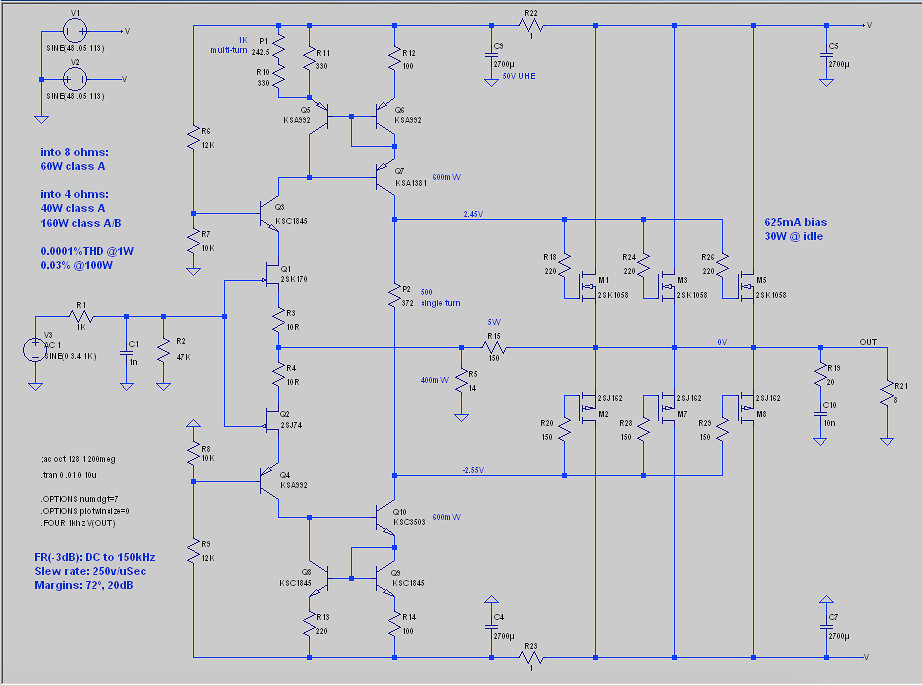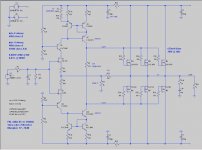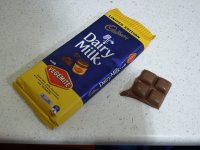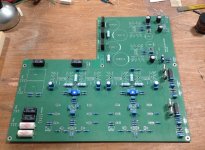The title was "an HPA-1-inspired power amp", right ?
Or we just want an open discussion as to what Jeff should build ?
The HPA-1 topology is based on complementary JFET input, BJT current mirrored into complementary MOSFET followers, with loop NFB.
To cope with the higher rail voltages, it is necessary to cascode the JFETs, as posted.
Whether 3-BJT or 4-BJT current mirrors are used is a matter of taste.
I like symmetry, so I would use 4.
Using lateral MOSFETs means you can have 3 in parallel and still easy enough to drive.
IMHO there is no need to use a Vbe multiplier for bias, as the laterals do not need thermal compensation.
And I do not see any need or benefit to use the F5 type feedback.
That was why I posted the link to the UTHAiM power amp.
It essentially fits all the above, except for one pair of output devices.
And I am sure you know how to change the CM to BJT's.
Cheers,
Patrick
Or we just want an open discussion as to what Jeff should build ?
The HPA-1 topology is based on complementary JFET input, BJT current mirrored into complementary MOSFET followers, with loop NFB.
To cope with the higher rail voltages, it is necessary to cascode the JFETs, as posted.
Whether 3-BJT or 4-BJT current mirrors are used is a matter of taste.
I like symmetry, so I would use 4.
Using lateral MOSFETs means you can have 3 in parallel and still easy enough to drive.
IMHO there is no need to use a Vbe multiplier for bias, as the laterals do not need thermal compensation.
And I do not see any need or benefit to use the F5 type feedback.
That was why I posted the link to the UTHAiM power amp.
It essentially fits all the above, except for one pair of output devices.
And I am sure you know how to change the CM to BJT's.
Cheers,
Patrick
> And I did a second version using the front end from Nelson's Sony VFET article
Zenquito
http://phd-audio.fr/assets/amplis-shémas-et-cartouches.pdf
Patrick
Zenquito
http://phd-audio.fr/assets/amplis-shémas-et-cartouches.pdf
Patrick
Patrick,
With all due respect the Zenquito and variants (Plantefeve-France) are simple elegant amplifiers but in my opinion lack the sophistication in performance that Jeff is trying to achieve.
The VAS has issues that are made worse when mosfets are used in that position. Global feedback is used to hide some of these issues but in my book you should obtain maximum linearity and bandwidth (open loop bandwidth should exceed the audio bandwidth) before the application of feedback.
Several authors including John Curl, I believe, have mentioned this issue with the VAS.
There are ways around this problem but only with added complexity.
This was the case in the design of the HPA-1, I could have have used the Zenquito topology(which I built) but this did not fare so well in listening tests, the current mirror approach sounded much better, for not much more added complexity.
Jam
With all due respect the Zenquito and variants (Plantefeve-France) are simple elegant amplifiers but in my opinion lack the sophistication in performance that Jeff is trying to achieve.
The VAS has issues that are made worse when mosfets are used in that position. Global feedback is used to hide some of these issues but in my book you should obtain maximum linearity and bandwidth (open loop bandwidth should exceed the audio bandwidth) before the application of feedback.
Several authors including John Curl, I believe, have mentioned this issue with the VAS.
There are ways around this problem but only with added complexity.
This was the case in the design of the HPA-1, I could have have used the Zenquito topology(which I built) but this did not fare so well in listening tests, the current mirror approach sounded much better, for not much more added complexity.
Jam
Last edited:
It was Jeff, not me, who posted essentially an F5 with added follower.
Which is of course nearly the same topology as the Zenquito.
I am not proposing which is better and which is worse.
Just merely pointing out similar implementations.
The intrinsic linearity always depends on the implementation, even with the same topology.
Choice of components and operating points being a large part.
I design and build amps without NFB.
So I know what lntrinsic lineairty means.
Cheers,
Patrick
Which is of course nearly the same topology as the Zenquito.
I am not proposing which is better and which is worse.
Just merely pointing out similar implementations.
The intrinsic linearity always depends on the implementation, even with the same topology.
Choice of components and operating points being a large part.
I design and build amps without NFB.
So I know what lntrinsic lineairty means.
Cheers,
Patrick
Jeff, why two 2SK170's in the CCS? PD?
No, it's similar to a cascode: it keeps the Vgs of each one within spec. Not something I've seen before, but it seems to work.
The title was "an HPA-1-inspired power amp", right ?
Or we just want an open discussion as to what Jeff should build ?
Hi Patrick,
That was probably a poor title choice on my part. What I'd like the thread to be (and what it has been a pretty good facsimile of so far), is:
"What's an interesting topology using laterals to compare Beefcake too?"
For those that don't want to dive into Beefcake, it's a JFET LTP feeding a single-ended MOSFET VAS feeding a pile of vertical MOSFETs, with front-end loop feedback.
Oh, and as the comparison is to Beefcake, it needs to drive 4-ohm Maggies in a large room.
Cheers,
Jeff.
Note: I'm still working through some of the other ideas presented, so more later...
One thing I forgot to mention: I've shelved the push-pull MOSFET VAS for now. Irrespective of the issues Jam brings up, after 4 or 5 hours of playing with it I still get unexpected results when tweaking things, which is a pretty good indication that I'm out of my depth on that one (at least for now). I did learn some things, though, so all's good on that front.
FWIW, this is one of the things that drew me to the HPA-1. I had to do a lot of tweaking to make the parts I was guessing at work with the parts that I could see in the pictures, but by and large the tweaks didn't produce unexpected results.
FWIW, this is one of the things that drew me to the HPA-1. I had to do a lot of tweaking to make the parts I was guessing at work with the parts that I could see in the pictures, but by and large the tweaks didn't produce unexpected results.
Whether 3-BJT or 4-BJT current mirrors are used is a matter of taste.
I like symmetry, so I would use 4.
Turns out I know Jam pretty well. Well enough to know that he makes design choices based on sound quality, given a particular price target and or related constraints. He already said he tried a 4-bjt current mirror for the HPA-1 project and did not prefer its brightness compared to the 3-bjt version. Why would one design audio equipment based on a like of symmetry vs based on preferred sound quality?
> Why would one design audio equipment based on a like of symmetry vs based on preferred sound quality?
Everyone is free to do what he likes.
I chose to use 4 MOSFET for the current mirrors in UTHAiM.
My choice.
Sound quality is subjective.
We don't need to agree.
Cheers,
Patrick
Everyone is free to do what he likes.
I chose to use 4 MOSFET for the current mirrors in UTHAiM.
My choice.
Sound quality is subjective.
We don't need to agree.
Cheers,
Patrick
I'm following this thread with some interest. I have a stash of matched pairs of 2SK134 and 2SJ49 lateral Mosfets from the old Hafler amps that I've collected. Two of these chasis were completely refitted to build my enhanced ACA clones. I also have a couple amps with matched triplets. Besides making some simple upgrades to the Hafler circuit, I've been looking for a good design to run in Class A, with power rails around +/– 40V, using the Mosfets that I have saved.
Pico does bring up an interesting point.
With regards to the use of mosfets, the compliments (N&P devices) are usually quite different in characteristics, unlike bi-polars which would lend some support for his idea of a quasi-comp. mosfet output stage.
This is particularly true of the IRF devices. I would suggest the use of a linear and load tolerant output stage as possible and let the magic happen the input stage.
Just a thought,
Jam
With regards to the use of mosfets, the compliments (N&P devices) are usually quite different in characteristics, unlike bi-polars which would lend some support for his idea of a quasi-comp. mosfet output stage.
This is particularly true of the IRF devices. I would suggest the use of a linear and load tolerant output stage as possible and let the magic happen the input stage.
Just a thought,
Jam
Attachments
Last edited:
Mr JamJar
What is this business with Yeah Nah.
Hahahaha
So we're gonna aim for perfect as possible symmetry at output and add asymmetry at input?
This is something I have been pondering on for a while ie do I go perfect symmetry at input then asymmetry at output or asymmetry at input and perfect symmetry at output.
Given the unpredictable loads speakers present I have been thinking the asymmetry should be added at input, and making the output symmetrical as possible (while still being dumb).
What is this business with Yeah Nah.
Hahahaha
So we're gonna aim for perfect as possible symmetry at output and add asymmetry at input?
This is something I have been pondering on for a while ie do I go perfect symmetry at input then asymmetry at output or asymmetry at input and perfect symmetry at output.
Given the unpredictable loads speakers present I have been thinking the asymmetry should be added at input, and making the output symmetrical as possible (while still being dumb).
No worries, I've got a quasi-comp on the burner too. But that one's more of a history project trying to eek out exactly what Julian Vereker had in mind with the NAP250.
NAP250 amp boards & regulator boards
(Despite various schematics floating about, it was harder to reverse-engineer than the HPA-1. At least Occam's Razor works with Jam's designs; not so much with Julian's.)
Anyway, back to JamJar. Next iteration of the current mirror version, with simplified bias and feedback:

NAP250 amp boards & regulator boards
(Despite various schematics floating about, it was harder to reverse-engineer than the HPA-1. At least Occam's Razor works with Jam's designs; not so much with Julian's.)
Anyway, back to JamJar. Next iteration of the current mirror version, with simplified bias and feedback:
Attachments
Pico,
Just trying to be an Aussie......
Well be you have true complementary devices (usually bi-polars) but if we use mosfets like the IR devices maybe quasi-comp might be better.
Back to input stages, I find that complementary designs are a lot harder to get right that being said the second topology I proposed (Hitachi) done right it pretty symmetrical in its behavior (hint. current mirror)
Look what I found.........
Jam
Just trying to be an Aussie......
Well be you have true complementary devices (usually bi-polars) but if we use mosfets like the IR devices maybe quasi-comp might be better.
Back to input stages, I find that complementary designs are a lot harder to get right that being said the second topology I proposed (Hitachi) done right it pretty symmetrical in its behavior (hint. current mirror)
Look what I found.........
Jam
Attachments
> With regards to the use of mosfets, the compliments (N&P devices) are usually quite different in characteristics, ....
https://www.diyaudio.com/forums/headphone-systems/306350-uthaim-fun-2.html#post5338019
Patrick
https://www.diyaudio.com/forums/headphone-systems/306350-uthaim-fun-2.html#post5338019
Patrick
... Why would one design audio equipment based on a like of symmetry vs based on preferred sound quality?
Well, I'm on record as picking some components by colour. I like my stuff to look cool....
Attachments
Pico,
Just trying to be an Aussie......
Jam
Crikey mate, that's about as bloody fairdinkum Aussie as you can get.
- Home
- Amplifiers
- Pass Labs
- JamJar: an HPA-1-inspired power amp



